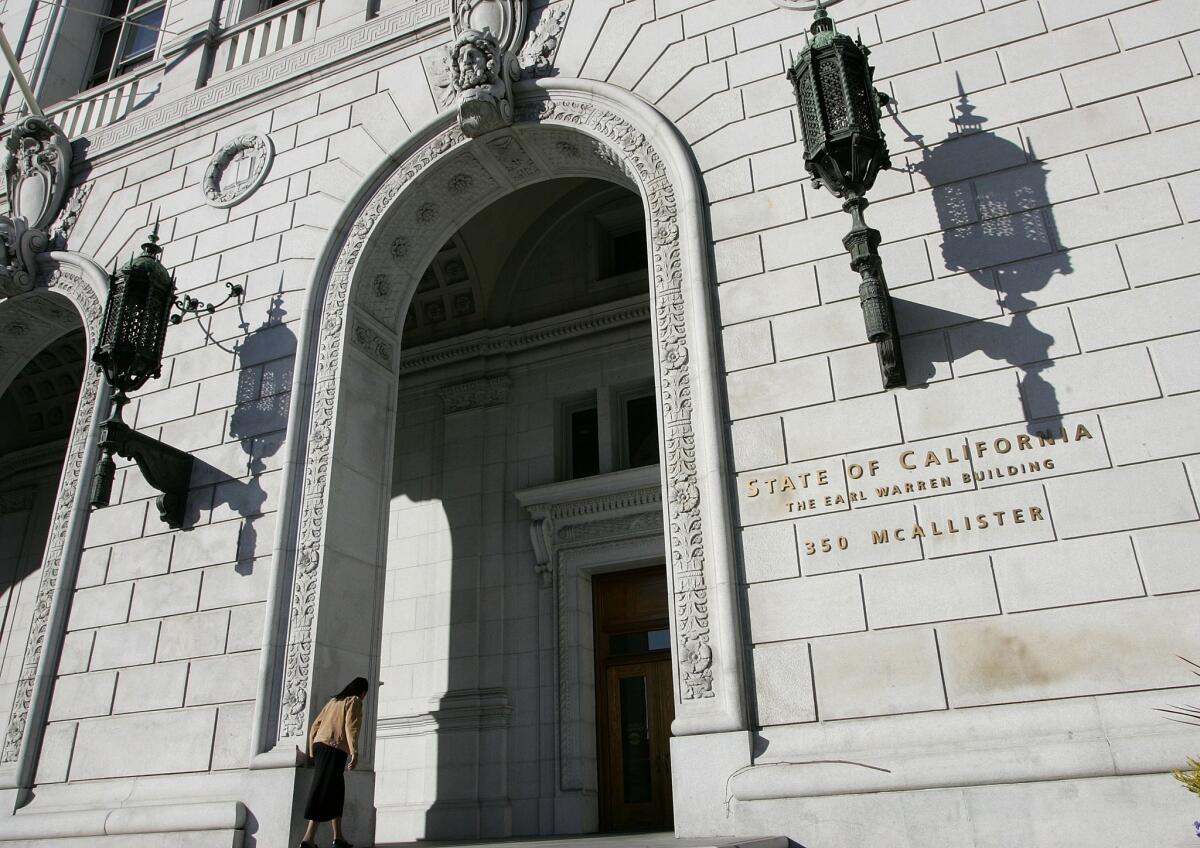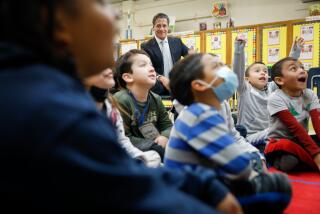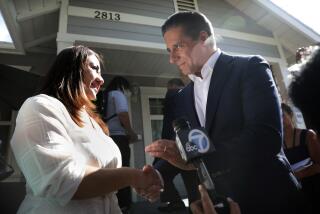My son ‘needs more than a screen’ mom says as LAUSD taken to court to partially reopen schools

- Share via
Five days after the Los Angeles Unified School District announced it was shutting down all campuses for limited in-person instruction, two children’s advocacy groups have asked the state’s highest court to require the system to partially reopen to serve its youngest students and those with special learning needs, according to court documents filed Friday.
In a petition filed with the California Supreme Court, the Alliance for Children’s Rights and the Learning Rights Law Center allege that L.A. Unified violated a state law that requires education agencies to offer in-person instruction “to the greatest extent possible.”
LAUSD had offered limited in-person tutoring and assessment for students with disabilities, reaching less than 1% of 465,000 students in kindergarten through 12th grade. And then on Monday Supt. Austin Beutner announced a hard shutdown of all campuses amid the unprecedented spike in cases.
“We have an imperative to get kids back to school as soon as possible the safest way possible,” Beutner said Monday, adding that “extraordinary and quite dangerous” infection rates were too high to allow for students and teachers to interact on campus, even with extensive safety protocols in place.
The law, passed in June, preserved funding for school districts at levels similar to the previous year, but also set broad guidelines intended to ensure that students would receive an appropriate education despite the pandemic. Recognizing the limitations of online learning, lawmakers specified that instruction should be conducted in person as much as possible and also that the length of instruction in minutes had to meet state minimum standards — although schools had much leeway in how they carried out instruction.
The state legislation requires school districts to address learning loss whenever possible through in-person classroom-based instruction, and L.A. Unified has failed to do that, said Alex G. Romain, a partner at Milbank LLP, which filed the suit on behalf of the organizations.
“There is no question that severe learning loss has already occurred, is ongoing, and will lead to irreparable harm for these students. This slow-motion catastrophe — with potentially irreversible and life-long negative consequences for students— can and should be immediately addressed,” the petition states. It also states that “in-person instruction in small cohorts is possibleas long as it is safe from a public health perspective.”
A spokesperson for the school district, asked about the petition, said, “We do not comment on pending litigation.”
Up till now, county health guidelines have governed how much instruction is permitted during the pandemic and then school districts can decide to be more restrictive. The litigation seeks to change that.
The advocacy groups seek to compel the district to provide as much in-person instruction as permitted under Los Angeles County public health guidelines.
Those directives allow for schools to offer instruction for students with special needs in groups of up to 12. And the total number of students on campus can equal up to 25% of a school’s total enrollment. The guidelines were established to help students in greatest need, including students with disabilities, English learners and those who are particularly struggling with distance learning. In addition, schools can apply for waivers to bring back their youngest — transitional kindergarten through second-graders — who are least able to learn via Zoom and other online platforms.
“While distance learning is a challenge for everyone … for some students, it is simply impossible,” Romain said in an interview. The district’s latest move to shut down all in-person services, was a step in the wrong direction, Romain said.
Jennifer Braun, president and CEO of the Alliance for Children’s Rights, said it was “crucial” that the group take action now, as families and children are becoming more distraught with the limitations of remote learning.
“These are essential services” for children, she said. “I don’t see how it’s any different than people having appointments with their doctors. It’s to address that immediate need.”
The lawsuit alleges that the school district could have taken steps to resume some in-person classes as early as September with safety protocols in place. The school year began in mid-August and the district has previously said it began its one-on-one tutoring program in October.
Last month, Milbank and the Alliance for Children’s Rights wrote a letter to the district demanding information on how officials planned to serve students with special needs during the pandemic.
In response, Devora Navera Reed, the interim general counsel for LAUSD, said that some in-person instruction began in the latter part of September. But the county’s stringent guidelines, which call for a 14-day quarantine if an individual in a cohort tests positive for COVID-19, could lead to multiple and consecutive quarantines, according to the letter.
“We have seen this play out in real time in several school districts, and the unpredictability of opening and closing of classes has been very disruptive to students and families, and students with social-emotional challenges can be particularly adversely impacted by the lack of consistency,” she wrote in a letter dated Nov. 12.
Still, Romain says, “LAUSD has done very little to be able to meet its obligation under the law.”
For Ariel Harman-Holmes remote learning has been challenging. Harman-Holmes, 40, took time off work as a lawyer to stay home with her children who are 2, 6 and 8 years old. All three have exceptional needs, she said.
But her 8-year-old, who is autistic, struggles with the online format — the glitches are distracting, and the Zoom classes can lead to a sensory overload. She said she has tried to get him assessed and placed in a specialized program, but the process was delayed by school closures. She said she has noticed he has regressed when it comes to writing, which now overwhelms him, and she feels he will get better with only with the help of a one-on-one aide.
“He needs more than a screen,” she said. “That’s not how his senses work. He can’t learn this way, he just can’t.”
In September, a class-action lawsuit filed on behalf of parents of LAUSD students accused the district of failing students through remote learning, many of whom are Black and Latino.
Separately, a group of Democratic state legislators are advocating for schools to begin planning for in-person instruction next semester. On Monday, Assemblyman Phil Ting (D-San Francisco) introduced a bill that would require educational agencies to establish in-person instruction within two weeks of public health orders that allow school campuses to open as early as March.
In a statement, Ting, a father of school-age children, said he is concerned about students who are falling behind because of “our sole reliance on remote teaching.” Low-income students at public schools are bearing the brunt of the school closures, as some private schools have already reopened, worsening achievement gaps, he said.
“Schools in other states and countries have prioritized in-person learning during COVID-19 and have done so without major outbreaks. California ought to follow that path,” Ting said.
More to Read
Sign up for Essential California
The most important California stories and recommendations in your inbox every morning.
You may occasionally receive promotional content from the Los Angeles Times.











